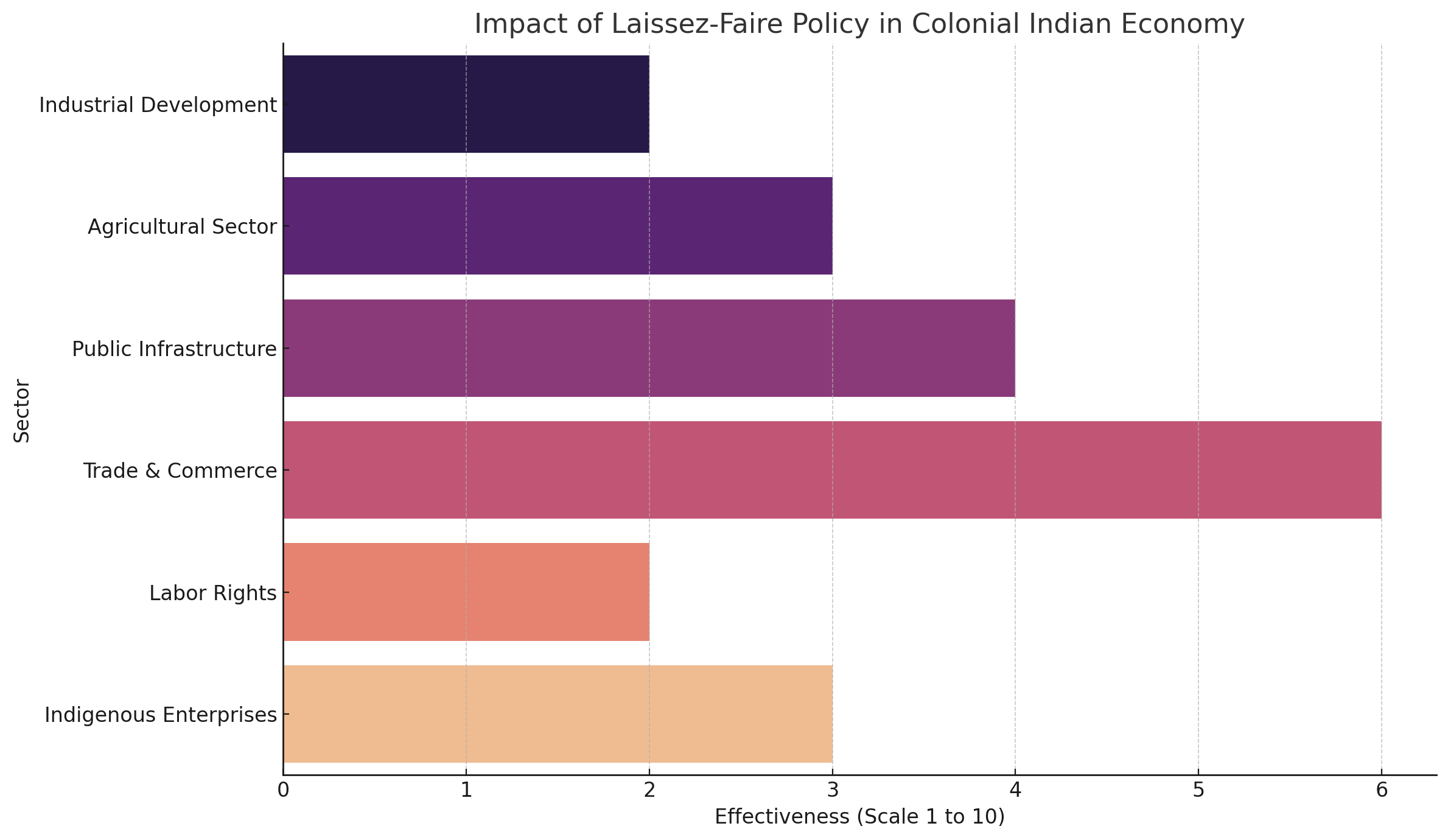
30 Jul Laissez Faire Theory and Critque
Laissez-Faire Theory and Critique in Indian Economy (Pre-Independence Era)
Introduction
The Laissez-Faire theory, which advocates minimal government intervention in economic affairs, became a central pillar of British colonial policy in India. While it was presented as a path to economic liberty and free market efficiency, its application in colonial India led to stagnation, industrial retardation, and widening socio-economic inequalities. The theory was severely criticized by Indian nationalists who saw it as a convenient justification for British non-responsibility toward Indian development.
What is Laissez-Faire?
The term “Laissez-Faire” is derived from the French phrase meaning “let do” or “let it be.” It refers to an economic philosophy of free-market capitalism that opposes government intervention. Developed during the classical liberal era of the 18th and 19th centuries, especially through the works of Adam Smith, the theory assumes that economies function most efficiently when left to the forces of supply and demand.
- No government interference in pricing or trade
- Encouragement of competition and entrepreneurship
- Private property as sacrosanct
- Minimal state expenditure on welfare or infrastructure
Adoption of Laissez-Faire in Colonial India
British administrators in India enthusiastically adopted the laissez-faire framework, but with a colonial twist. While it justified minimal development effort on the part of the government, it also enabled exploitative trade and extractive economic policies that served imperial interests. The British East India Company and later the Crown were committed to:
- Non-intervention in indigenous industry and agriculture
- Support for British imports and exporters
- Absence of protective tariffs for Indian products
- Negligence toward education, health, and rural development
Infographic: Sector-Wise Impact of Laissez-Faire
laissez faire mind map.png
Consequences of Laissez-Faire Policy in India
1. Industrial Backwardness
British refusal to protect Indian industries led to the destruction of traditional handicrafts. Cheap British imports flooded the Indian market due to lack of tariffs, leading to massive unemployment in cottage industries. No industrial policy or capital investment was made to modernize Indian manufacturing.
2. Agricultural Distress
The government avoided any intervention in agricultural markets even during famines. Peasants were left to face droughts, floods, and exploitation by moneylenders. Land revenue was collected regardless of produce failures, often resulting in land alienation.
3. Neglect of Infrastructure
Public works like irrigation canals, roads, and health infrastructure were ignored unless they served British military or commercial interests. The laissez-faire principle prevented investment in welfare-enhancing public goods.
4. No Labor Protection
There were no laws regulating working hours, wages, or worker safety. Child labor and bonded labor remained rampant under British indifference.
5. Trade Policy Bias
Indian exports faced no subsidies or institutional support, while British firms received contracts and concessions. The so-called “free trade” was asymmetrical and exploitative.
Criticism of Laissez-Faire in the Indian Context
1. Unsuitability for Colonial Setting
India lacked the capitalist class, technology, and capital base required to benefit from free markets. The laissez-faire model assumed an industrial society, not an agrarian, colonial one.
2. Lack of Protective Tariffs
Indian industries, unlike in Japan or the USA, received no protection during their formative stages. British textiles dominated Indian markets.
3. Disguised Exploitation
Laissez-faire was used to justify British non-investment in Indian welfare. While the British profited from trade and taxation, Indians were left to face famines, unemployment, and poverty.
4. No Reinvestment of Profits
Profits earned in India were transferred to Britain (Drain of Wealth) with no reinvestment into Indian development.
Mind Map: Laissez-Faire Theory in Colonial India

Indian Nationalist Response
Indian nationalists like Dadabhai Naoroji, Gopal Krishna Gokhale, and R. C. Dutt challenged the laissez-faire myth:
- Argued for state intervention in agriculture and industry
- Demanded protective tariffs and industrial policy
- Advocated for state-funded infrastructure and public health
The Swadeshi Movement (1905-11) was a direct economic response to this exploitative policy, calling for indigenous production and boycott of British goods.
Long-Term Impact and Legacy
- Created a dualistic economy: extractive colonial elite vs poor agrarian majority
- Stifled capital formation and entrepreneurship in India
- Fuelled nationalist demands for planned development post-1947
Post-independence India decisively rejected laissez-faire by adopting planned economy through Five Year Plans and state ownership in key sectors.
Key Thinkers & Writings
- Poverty and Un-British Rule in India – Dadabhai Naoroji
- The Economic History of India – R. C. Dutt
- Speeches of Gopal Krishna Gokhale in Imperial Legislative Council
- Tagore and Gandhi’s critique of economic inequality
Previous Year Questions (PYQs)
- Critically examine the application of laissez-faire in colonial Indian economy. (UPSC CSE 2015)
- How did the British policy of non-intervention affect Indian industries during the 19th century? (UPSC CSE 2017)
- To what extent did laissez-faire policies contribute to the economic drain from India? (UPSC CSE 2020)
Probable Questions for Upcoming Exams
- Discuss the applicability and consequences of laissez-faire theory in the Indian colonial context.
- Explain how laissez-faire policy served British imperial economic interests.
- Why was laissez-faire unsuitable for a developing country like India under colonial rule?
- Examine the Indian nationalist response to laissez-faire economic policies.




No Comments